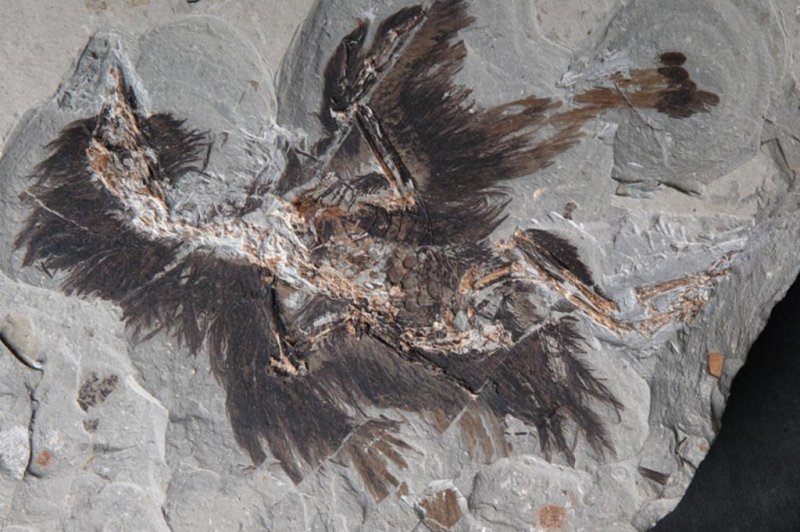Researchers found pigment-producing organelles as well keratin, a protein that protects skin cells, preserved in the feathers of an ancient bird fossil. Photo by Xiaoli Wang/N.C. State
RALEIGH, N.C., Nov. 21 (UPI) -- Keratin and melanosomes can remain preserved and later identified in fossilized tissue. The revelation comes thanks to the discovery of an ancient bird fossil, a 130 million-year-old Eoconfuciusornis specimen recovered in China.
Identifying microstructures in fossilized tissued is problematic. Until now, researchers couldn't be sure what looked like melanosomes were indeed melanosomes.
Scientists have found small, round microstructures, which appeared to be preserved pigment-producing organelles, in several ancient dinosaur and bird specimens. But researchers warned such structures could just as easily be microbes.
"If these small bodies are melanosomes, they should be embedded in a keratinous matrix, since feathers contain beta-keratin," Mary Schweitzer, a professor biology at North Carolina State University, said in a news release. "If we couldn't find the keratin, then those structures could as easily be microbes, or a mix of microbes and melanosomes -- in either case, predictions of dinosaur shading would not be accurate."
The newly recovered bird specimen offered the first evidence of melanosomes embedded in preserved keratin -- the protein that protects epithelial cells and lends the quality of toughness to the skin of reptiles, birds, amphibians and mammals.
Eoconfuciusornis was a primitive crow-like bird that lived in Asia during the Cretaceous period. It's the earliest known bird to boast a toothless keratin beak like modern birds.
Scientists confirmed the presence of preserved keratin molecules in the Eoconfuciusornis specimen using a combination of scanning and transmission electron microscopy. Researchers also used immunogold labeling, whereby secondary antibodies marked by gold nanoparticles attach to primary antibodies in a target protein on cell component.
Image mapping using copper and sulfur confirmed the identities of the preserved microstructures. Sulfur binds to keratin and melanin molecules, while copper only targets melanin.
Researchers detailed their discovery in the Proceedings of the National Academy of Sciences.
"This study is the first to demonstrate evidence for both keratin and melanosomes, using structural, chemical and molecular methods," said study co-author Yanhong Pan, associate research fellow at the Chinese Academy of Sciences. "These methods have the potential to help us understand -- on the molecular level -- how and why feathers evolved in these lineages."















